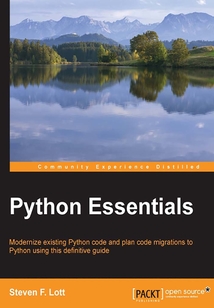目錄(145章)
倒序
- 封面
- 版權信息
- Credits
- About the Author
- About the Reviewers
- www.PacktPub.com
- Preface
- Chapter 1. Getting Started
- Installation or upgrade
- Using the Read-Evaluate-Print Loop (REPL)
- Interacting with the help subsystem
- Creating simple script files
- The Python ecosystem
- Looking at other Python interpreters
- Summary
- Chapter 2. Simple Data Types
- Introducing the built-in operators
- The numeric tower
- The math libraries
- Using bits and Boolean values
- Working with sequences
- Using string and bytes values
- Using the tuple collection
- The None object
- The consequences of immutability
- Using the built-in conversion functions
- Summary
- Chapter 3. Expressions and Output
- Expressions operators and data types
- The print() function
- Examining syntax rules
- Splitting partitioning and joining strings
- Summary of the standard string libraries
- Summary
- Chapter 4. Variables Assignment and Scoping Rules
- Simple assignment and variables
- Multiple assignment
- Using the head *tail assignment
- Augmented assignment
- The input() function
- Python language concepts
- The Python namespace concept
- Summary
- Chapter 5. Logic Comparisons and Conditions
- Boolean data and the bool() function
- Comparison operators
- Logic operators – and or not if-else
- The if-elif-else statement
- The pass statement as a placeholder
- The assert statement
- The logic of the None object
- Summary
- Chapter 6. More Complex Data Types
- The mutability and immutability distinction
- Using the list collection
- Using collection functions
- Using the set collection
- Mappings
- Processing collections with the for statement
- Iterating with the while statement
- The continue and break statements
- Using the else clause on a loop
- Summary
- Chapter 7. Basic Function Definitions
- Looking at the five kinds of callables
- Defining functions with positional parameters
- Mutable and immutable argument values
- Defining optional parameters via default values
- Using the "everything else" notations of * and **
- Nested function definitions
- Working with namespaces
- Defining lambdas
- Writing additional function annotations
- Summary
- Chapter 8. More Advanced Functions
- Using the for statement with iterable collections
- Consequences and next steps
- Using generator expressions and comprehensions
- Defining generator functions with the yield statement
- Using the higher-order functions
- Using the built-in reductions – max min and reduce
- Three ways to sort a sequence
- Functional programming design patterns
- Summary
- Chapter 9. Exceptions
- The core exception concept
- Using the try and except statements
- Matching exception classes in an except clause
- Creating our own exceptions
- Using a finally clause
- Use cases for exceptions
- Issuing warnings instead of exceptions
- Permission versus forgiveness – a Pythonic approach
- Summary
- Chapter 10. Files Databases Networks and Contexts
- The essential file concept
- Using a context manager via the with statement
- Using the shelve module as a database
- Web services and Internet protocols
- Physical format considerations
- Summary
- Chapter 11. Class Definitions
- Creating a class
- Writing the suite of statements in a class
- Using instance variables and methods
- Pythonic object-oriented programming
- Using properties
- Using inheritance to simplify class definitions
- Using class methods and attributes
- Using __slots__ to save storage
- The ABCs of abstract base classes
- Summary
- Chapter 12. Scripts Modules Packages Libraries and Applications
- Script file rules
- Running a script by the filename
- Creating a reusable module
- Creating a hybrid library/application module
- Creating a package
- Designing alternative implementations
- Seeing the package search path
- Summary
- Chapter 13. Metaprogramming and Decorators
- Simple metaprogramming with decorators
- Defining our own decorator
- More complex metaprogramming with metaclasses
- Summary
- Chapter 14. Fit and Finish – Unit Testing Packaging and Documentation
- Writing docstrings
- Writing unit tests with doctest
- Using the unittest library for testing
- Using other add-on test libraries
- Logging events and conditions
- Writing documentation with RST markup
- Organizing Python code
- Summary
- Chapter 15. Next Steps
- Leveraging the standard library
- Leveraging PyPI – the Python Package Index
- Types of applications
- Building CLI applications
- Building GUI applications
- Building web applications
- Plugging into a MapReduce framework
- Summary
- Index 更新時間:2021-07-16 13:53:31
推薦閱讀
- Vue.js快速入門與深入實戰
- Mastering Entity Framework
- 我的第一本算法書
- 微信小程序開發解析
- Swift語言實戰精講
- Linux C編程:一站式學習
- TMS320LF240x芯片原理、設計及應用
- R數據科學實戰:工具詳解與案例分析
- Python網絡爬蟲技術與應用
- Mastering Apache Camel
- Spring Boot從入門到實戰
- Less Web Development Cookbook
- VMware vSphere 5.5 Cookbook
- Python無監督學習
- Head First Kotlin程序設計
- ANSYS FLUENT 16.0超級學習手冊
- Magento 2 Developer's Guide
- Python 3程序設計基礎
- Unreal Engine 4 Game Development Quick Start Guide
- RESTful Web Services with Dropwizard
- Python大數據分析算法與實例
- Node.js Design Patterns(Second Edition)
- C語言學習指南:從規范編程到專業級開發
- Python 3.8從零開始學
- 深入探索JVM垃圾回收:ARM服務器垃圾回收的挑戰和優化
- Web前端自動化構建:Gulp、Bower和Yeoman開發指南
- Building Applications with Spring 5 and Vue.js 2
- R數據可視化手冊(第2版)
- Learning Angular
- 從零開始學C程序設計


